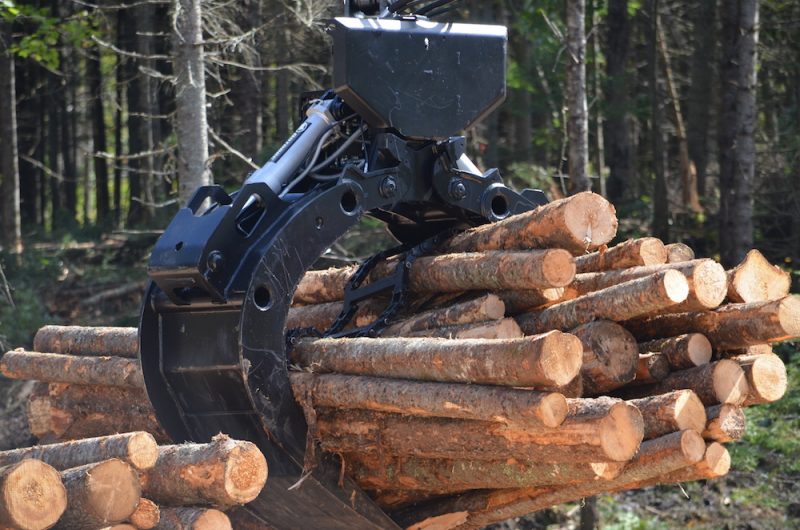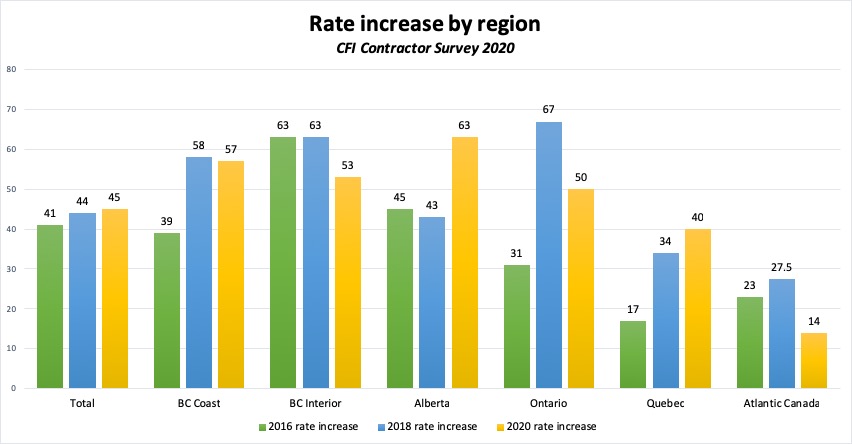
Features
Harvesting
Logging Profiles
Survey snippet 1: Logging rate increases vary
August 11, 2020 By Ellen Cools
 Photo: Annex Business Media
Photo: Annex Business Media More than a quarter of contractors across Canada (27 per cent) say their logging rates have not changed in the past five years, based on the results of Canadian Forest Industries’ 2020 Contractor Survey. In comparison, 36 per cent of contractors said their rates remained unchanged in CFI‘s 2018 Contractor Survey.
Meanwhile, 45 per cent of contractors said their rates have increased – just one per cent higher than in 2018. This means that for the majority of contractors, logging rates are either increasing or holding steady.
But, there was a slight increase in the percentage of contractors who say their rates have decreased – 14 per cent compared to 11 per cent in 2018. This is still much better than in 2016, when 23 per cent said their rates had decreased. Fifteen per cent of respondents reported that they were either too new to compare rates or did not know.
These numbers differ greatly from East to West. In general, contractors in the western provinces have had better success negotiating rates, with those in Alberta coming out on top – 63 per cent of contractors in the province reported an increase in rates, and only nine per cent reported a decrease in 2020. More than half of all contractors in the B.C. Coast and Interior B.C. reported a rate increase – 57 per cent and 53 per cent, respectively.
However, the number of contractors who say rates have decreased has also gone up. In the B.C. Coast, 13 per cent reported a decrease of more than five per cent, while in Interior B.C., 14 per cent reported a decrease of three to five per cent. This change might be as a result of the long Western Forest Products strike on the Coast, which lasted for eight months.
Similarly, 12 per cent of contractors in Ontario reported rates had decreased by five per cent or less. But 50 per cent reported an increase, while 31 per cent said rates have held steady.
Quebec had the lowest percentage of contractors reporting a decrease in rates at just six per cent, but only 40 per cent reported an increase, while 17 per cent said rates have stayed the same. A large number of respondents from the province – 34 per cent – either didn’t know or were too new to compare rates.
News in Atlantic Canada has not improved since 2018, especially in Nova Scotia, where the Northern Pulp closure has severely impacted the industry. In 2018, 17 per cent of contractors in Atlantic Canada reported lower rates compared to five years ago. In 2020, that number has jumped to 28.5 per cent.
The region also had the highest percentage of contractors reporting that rates have not changed, at 46.5 per cent, similar to 2018, when 47 per cent said rates were the same. The outlook in Atlantic Canada is bleak, with only 14 per cent reporting an increase in rates. In Nova Scotia alone, zero per cent of contractors reported an increase.

Percentage of contractors reporting some rate increase compared to 2018 and 2016.
Look for more news from the CFI 2020 Contractor Survey on www.woodbusiness.ca and in our eNews over the coming weeks, with a final digital report in December and a summary in the November/December print issue. Be sure to subscribe to our free eNews to get all the latest industry news.
This survey was conducted in April and May 2020 by independent research firm Bramm & Associates, generating 271 replies to a detailed list of questions. Respondents were distributed according to the geographic breakdown of the forest industry, with 44 per cent of respondents in Western Canada, 26 per cent in Quebec and the rest found in Ontario, Atlantic Canada, and central Canada. Within B.C., responses were split between the B.C. Coast and Interior. Many thanks to our sponsors for making this research possible – Hultdins, Tigercat and John Deere.
Editor’s note: An earlier version of this article incorrectly stated that 28 per cent of contractors in Atlantic Canada reported a rate increase. The correct number is 14 per cent. CFI apologizes for this error.
Print this page